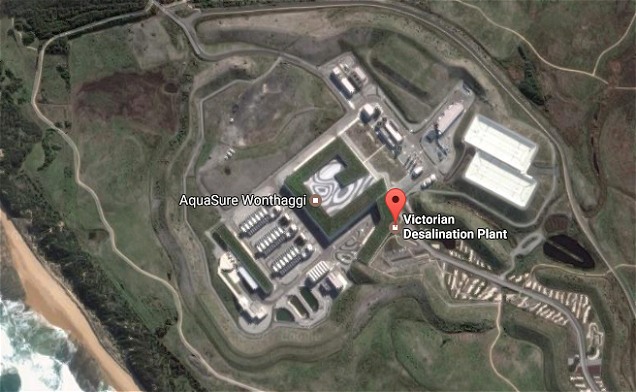
Victorian Desalination Plant, Wonthaggi | Image: Google Maps
The Victorian Government says the water order from the Victorian Desalination Plant for 2017/8 will be 15 gigalitres, but Melbourne households won’t be slugged with additional water bill charges.
This order and the 50GL order made for 2016-17 will be funded from the sale of surplus Renewable Energy Certificates, previously purchased to offset electricity consumed by the plant and transfer pipeline operations. The certificates were not fully utilised as orders weren’t placed until last year.
The purchase of the certificates helped fund construction of the 63 megawatt Oaklands Hill and 420 megawatt Macarthur wind farm, other wind energy facilities, solar power and landfill gas-to-power projects.
The Victorian Desalination Plant certainly isn’t an electricity sipper.
“About 90MW is required to run the plant and pipeline when it is operating at 150GL,” says the plant’s operator, Aquasure.
“The desalination plant’s energy consumption per household per day represents about the same amount as a 4-star fridge.”
This mightn’t sound like a huge amount, but collectively we’re talking about more than 1.5 million fridges.
The Government says Melbourne’s water storage situation has never fully recovered from the millennium drought and despite inflows from the plant and rainfall, storage capacity declined between late November last year and 11 May 2017 to 105 GL lower than this time two years ago.
“The plant was not built to be turned on just when our water supply reached critical levels. Instead its aim is to make sure that our water supply doesn’t fall to those levels in the first place,” said Minister for Water Lisa Neville.
“No one’s water bills will increase due to this water order. There will be no additional charges for this year’s water orders – or the minimum water orders of 15 GL for the next three years – passed on to consumers.”
The Victorian Desalination Plant, located at Wonthaggi, has been a very controversial project, with cost blowouts and delays.
While it’s a nice idea to offset its electricity consumption with renewables and the money spent went towards building new wind, solar and other green energy capacity, it’s been suggested that a greater focus on domestic rainwater storage and other relatively simple water efficiency practices could have avoided the need for the plant altogether.
Others point out Melbourne’s population isn’t getting any smaller and the threat of drought always looms large in Australia; even more so now with the effects of climate change.

 RSS - Posts
RSS - Posts



Speak Your Mind